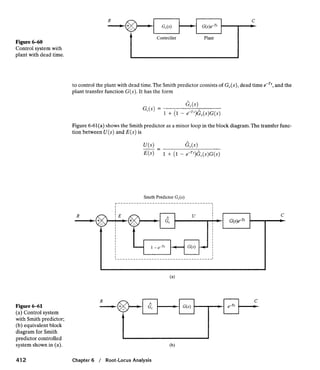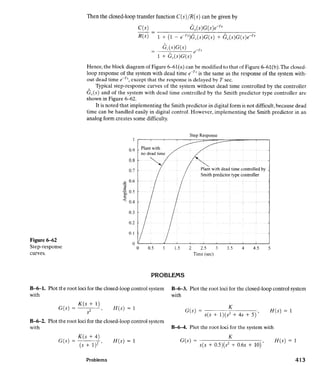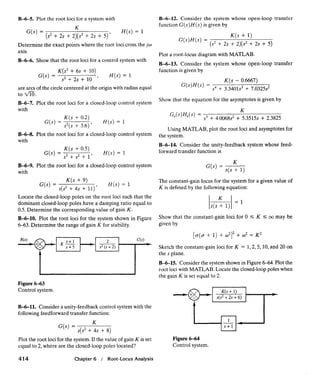The document discusses root locus analysis and provides examples of solving for root loci of different control systems. It contains:
1) An example problem walking through the steps to sketch the root loci of a control system, including locating poles and zeros, finding breakaway/break-in points, and determining where loci cross the imaginary axis.
2) Additional example problems providing the solutions for sketching various other control system root loci, using the same procedure and noting how the system response depends on the location of closed-loop poles.
3) Details on how to determine asymptotes, departure angles, and intersection points used in the root locus analysis of different order systems.


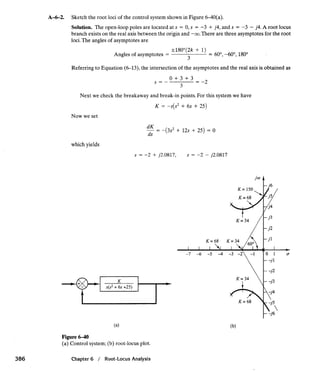
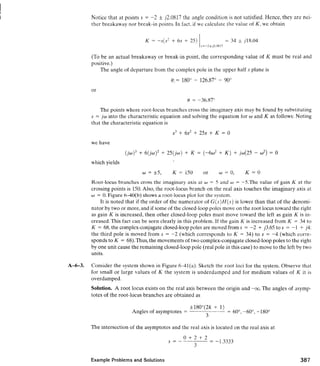






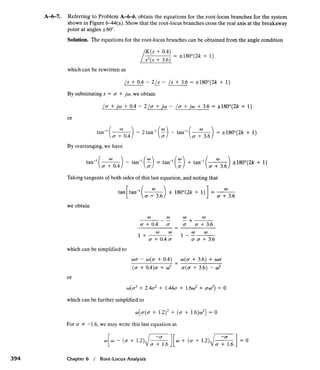
![which gives the equations for the root-locus as follows:
w = o
The equation w = 0 represents the real axis. The root locus for 0 5 K 5 co is between points
s = -0.4 and s = -3.6. (The real axis other than this line segment and the origin s = 0 corre-
sponds to the root locus for -w 5 K < 0.)
The equations
represent the complex branches for 0 5 K 5 m.These two branches lie between a = -1.6 and
u = 0. [See Figure 6-44(b).] The slopes of the complex root-locus branches at the breakaway
point ( a = -1.2) can be found by evaluating d o l d a of Equation (6-21) at point a = -1.2.
Since tan-' a= 60°, the root-locus branches intersect the real axis with angles +60°
A-6-8. Consider the system shown in Figure 6-45(a), which has an unstable feedforward transfer func-
tion. Sketch the root-locus plot and locate the closed-loop poles. Show that, although the closed-
loop poles lie on the negative real axis and the system is not oscillatory,the unit-step response curve
will exhibit overshoot.
Solution. The root-locus plot for this system is shown in Figure 6-45(b).The closed-loop poles are
located at s = -2 and s = -5.
The closed-loop transfer function becomes
(a)
Figure 6-45
:a) Control system; (b) root-locus plot
Example Problems and Solutions
LClosed-loop zero](https://image.slidesharecdn.com/exampleproblemsandsolutionsogatarootlocus-190823175908/85/Example-problems-and_solutions_ogata_root_locus-12-320.jpg)
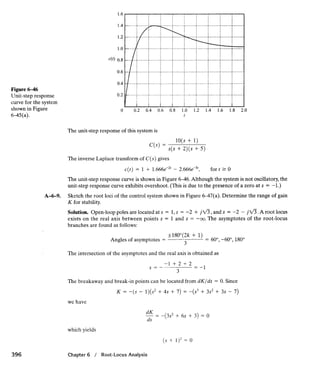


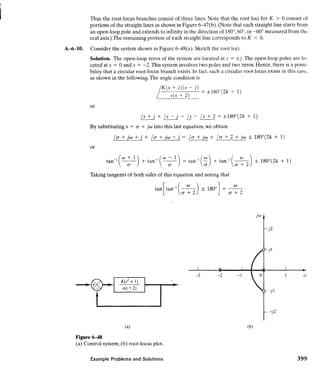

![Figure (is0
Root-locus lot.
Root-Locus Plot of G(s) = K(s+0.4)/[s2(s+3.6)]
Real Axis
In the problem considered here, the critical region of gain K is between 4.2 and 4.4.Thus we
need to set the step size small enough in this region. We may divide the region for K as tollows:
Entering MATLAB Program 6-12 into the computer,we obrain the plot as shown in Figure 6-51,
If we change the plot command plot(r,'o')in MATLAB P r ~ g r a m6-12 to plot(r,'-'1,we obtain Fig-
ure 6-52. Figures 6-51 and 6-52 respectively, show satisfa~tc~ryroot-locus plots.
MATLAB Program 6-1 2
"A, -----.---- Root-locus plot ----------
num = [O 0 I 0.41;
den = [I 3.6 0 01;
K1 = [0:0.2:4.21;
K2 = [4.2:0.002:4.4];
K3 = [4.4:0.2:10];
K4 = [I 0:5:200];
K = [KI K2 K3 K4];
r = rlocus(num,den,K);
plot(r,'ol)
v = [-5 1 -5 51; axis(v)
grid
titIe('Root-Locus Plot of G(s) = K(s+ 0.4)/[sA2(s
xlabel('Rea1Axis')
ylabel('lmag Axis')
Example Problems and Solutions](https://image.slidesharecdn.com/exampleproblemsandsolutionsogatarootlocus-190823175908/85/Example-problems-and_solutions_ogata_root_locus-18-320.jpg)
![Figure 6 5 1
Root-locus plot.
Figure 6 5 2
Root-locus plot.
Root-Locus Plot of G(s) = K(s+O 4)/[s2(s+3.6)]
5
0
-5 1 6
0
-5 -4 -3 -2 -1 0
Real AXIS
Root-Locus Plot of G(s)= K(s+0.4)/[s2(s+3.6)]
Real Axis
A-6-12. Consider the system whose open-loop transfer function G ( s ) H ( s )is given by
Using MATLAB,plot root loci and their asymptotes.
Solution. We shall plot the root loci and asymptotes on one diagram.Since the open-loop trans-
fer function is given by
G ( s ) H ( s )= -
K
s(s + l ) ( s + 2 )
-- K
s3 + 3s2 + 2s
the equation for the asymptotes may be obtained as follows:Noting that
lim
K
= lim
K K=-
3+m s3 + 3~~ + 2~ S-'m S~ + 3 ~ 2+ 3~ + 1 ( S + q3
Chapter 6 / Root-Locus Analysis](https://image.slidesharecdn.com/exampleproblemsandsolutionsogatarootlocus-190823175908/85/Example-problems-and_solutions_ogata_root_locus-19-320.jpg)
![the equation for the asymptotes may be given by
num = [O O O 11
den = [I 3 2 01
and for the asymptotes,
numa = [O O O 11
dena = [I 3 3 11
In using the following root-locus and plot commands
the number of rows of r and that of a must be the same.To ensure this, we include the gain con-
stant K in the commands. For example,
MATLAB Program 6-1 3
num = [O O O I];
den = [I 3 2 01;
numa = [O 0 0 1I;
dena = [I 3 3 1I;
K1 = 0:0.1:0.3;
K2 = 0.3:0.005:0.5;
K3 = 0.5:0.5:10;
K4 = 1O:S:I 00;
K = [Kl K2 K3 K4];
r = rlocus(num,den,K);
a = rlocus(numa,dena,K);
y = [r a];
plot(y,'-'1
v = [-4 4 -4 41; axis(v)
grid
title('Root-LocusPlot of G(s)= K/[s(s+ 1)(s + 2)) and Asymptotes')
xlabel('Rea1Axis')
ylabeU1lmagAxis')
***** Manually draw open-loop poles in the hard copy *****
Example Problems and Solutions](https://image.slidesharecdn.com/exampleproblemsandsolutionsogatarootlocus-190823175908/85/Example-problems-and_solutions_ogata_root_locus-20-320.jpg)
![Root-Locus Plot of G(s) = Ki[(.s(s+l)(s+2)]and Asymptotes
Figure 6-53
Root-locus plot. Real Axis
Including gain K in rlocuscommand ensures that the r matrix and a matrix have the same number of
rows.MATLAB Program 6-13 will generate a plot of root loci and their asymptotes.SeeFigure6-53.
Drawing two or more plots in one diagram can also be accomplished by using the hold com-
mand. MATLAB Program 6-14 uses the hold command. The resulting root-locus plot is shown
in Figure 6-54.
MATLAB Program 6-1 4
01~------------ Root-Locus Plots ------------
num = [O 0 0 1I;
den = [ I 3 2 01;
numa = [O 0 0 11;
dena = (1 3 3 1I;
K1 = 0:0.1:0.3;
K2 = 0.3:O.OOS:O.S;
K3 = O.5:0.5:10;
K4 = 10:5:100;
K = [Kl K2 K3 K4];
r = rlocus(num,den,K);
a = rlocus(numa,dena,K);
plot(r,'ol)
hold
Current plot held
plot(a,'-'1
v = [-4 4 -4 41; axis(v)
grid
title('Root-Locus Plot of G(s) = K/[s(s+l )(s+2)1and Asymptotes')
xlabel('Rea1Axis')
ylabel('lmagAxis')
Chapter 6 / Root-Locus Analysis
.1](https://image.slidesharecdn.com/exampleproblemsandsolutionsogatarootlocus-190823175908/85/Example-problems-and_solutions_ogata_root_locus-21-320.jpg)
![Root-Locus Plot of G(s) = Ki[.s(s+l)(s+2)]and Aysmptotes
Figure 6-54
Root-locus plot. Real Axis
Consider a unity-feedback system with the following feedforward transfer function G ( s ) :
K ( s + 2)'
C ( s ) = -
(s' + 4)(s + 5)'
Plot root loci for the system with MATLAB.
Solution. A MATLAB program to plot the root loci is given as MATLAB Program 6-15. The
resulting root-locus plot is shown in Figure 6-55.
Notice that this is a special case where no root locus exists on the real axis.This means that
for any value of K > 0 the closed-loop poles of the system are two sets of complex-conjugate
poles. (No real closed-loop poles exist.) For example, with K = 25, the characteristic equation
for the system becomes
s4 + 10s' + 54s' + 140s + 200
= (sL+ 4s + 10)(s2+ 6s + 20)
= (S + 2 + j2.4495)(s + 2 - j2.44!X)(s + 3 + ;3.3166)(s + 3 - j3.3166)
MATLAB Program 6-1 5
% ------------ Root-Locus Plot ------------
num = [O 0 1 4 41;
den = [I 10 29 40 1001;
r = rlocus(nurn,den);
plot(r,'ol)
hold
current plot held
plot(r,'-'1
v = [-8 4 -6 61; axis(v); axis('squarel)
grid
title('Root-Locus Plot of G(s) = (s + 2)"2/[(sA2 + 4)(s + 5)"211)
xlabel('Rea1Axis')
ylabel('lmag Axis')
Example Problems and Solutions](https://image.slidesharecdn.com/exampleproblemsandsolutionsogatarootlocus-190823175908/85/Example-problems-and_solutions_ogata_root_locus-22-320.jpg)
![Root-Locus Plot of G(s)= ( ~ + 2 ) ~ / [ ( ~ ~ + 4 ) ( s + 5 ) * ]
Figure 6-55
Root-locus plot. Real Axis
Since no closed-loop poles exist in the right-half s plane, the system is stable for all values of
K > 0.
A-6-14. Consider a unity-feedback control system with the following feedforward transfer function:
Plot a root-locus diagram with MATLAB. Superimpose on the s plane constant 5 lines and con-
stant w , circles.
Solution. MATLAB Program 6-16 produces the desired plot as shown in Figure 6-56.
- - -
MATLAB Program 6-1 6
num = [0 0 1 21;
den = [I 9 8 01;
K = 0:0.2:200;
rlocus(num,den,K)
v = [ -10 2 -6 61; axis(v1; axis('squarel)
sgrid
title('Root-Locus Plot with Constant zeta Lines and Constant omega-n Circles')
gtext('zeta = 0.9')
gtext('0.7')
gtext('0.5')
gtext('0.3')
gtext('omega-n = 10')
gtext('8')
gtext('6')
gtext('4')
gtext('2')
Chapter 6 / Root-LocusAnalysis](https://image.slidesharecdn.com/exampleproblemsandsolutionsogatarootlocus-190823175908/85/Example-problems-and_solutions_ogata_root_locus-23-320.jpg)


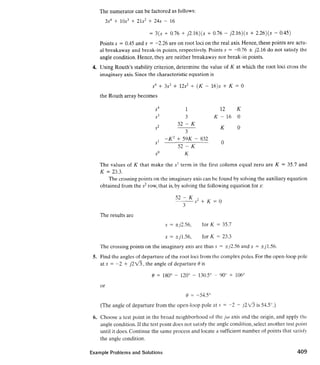
![Figure 6-58
Root-locus plot.
Figure 6-58 shows the root loci for this system. From step 4, the system is stable for
23.3 < K < 35.7. Otherwise,it is unstable.Thus, the system is conditionally stable.
Consider the system shown in Figure 6-59, where the dead time T is 1sec. Suppose that we ap-
proximate the dead time by the second-order pade approximation. The expression for this ap-
proximation can be obtained with MATLAB as follows:
[num,den] = pade(1, 2);
printsys(num, den)
numlden =
s"2 - 6s + 12
Hence
Using this approximation, determine the critical value of K (where K > 0) for stability.
Solution. Since the characteristic equation for the system is
s + 1 + Ke-" = 0
Chapter 6 / Root-LocusAnalysis](https://image.slidesharecdn.com/exampleproblemsandsolutionsogatarootlocus-190823175908/85/Example-problems-and_solutions_ogata_root_locus-27-320.jpg)

